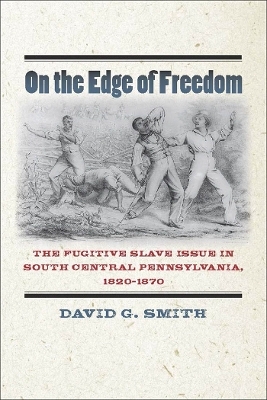
On the Edge of Freedom
Fordham University Press (Verlag)
978-0-8232-4032-6 (ISBN)
- Titel z.Zt. nicht lieferbar
- Versandkostenfrei innerhalb Deutschlands
- Auch auf Rechnung
- Verfügbarkeit in der Filiale vor Ort prüfen
- Artikel merken
In On the Edge of Freedom, David G. Smith breaks new ground by illuminating the unique development of antislavery sentiment in south central Pennsylvania—a border region of a border state with a complicated
history of slavery, antislavery activism, and unequal freedom. During the antebellum decades every single fugitive slave escaping by land east of the Appalachian Mountains had to pass through the region, where they faced both significant opportunities and substantial risks. While the hundreds of fugitives traveling
through south central Pennsylvania (defined as Adams, Franklin, and Cumberland counties) during this period were aided by an effective Underground Railroad, they also faced slave catchers and informers. “Underground” work such as helping fugitive slaves appealed to border antislavery activists who shied away from agitating for immediate abolition in a region with social, economic, and kinship ties to the South.
And, as early antislavery protests met fierce resistance, area activists adopted a less confrontational approach, employing the more traditional political tools of the petition and legal action.
Smith traces the victories of antislavery activists in south central Pennsylvania, including the achievement of a strong personal liberty law and the aggressive prosecution of kidnappers who seized innocent African Americans as fugitives. He also documents how their success provoked Southern retaliation and the passage of a strengthened Fugitive Slave Law in 1850. The Civil War then intensified the debate over fugitive slaves, as hundreds of escaping slaves, called “contrabands,” sought safety in the area, and scores were recaptured by the Confederate army during the Gettysburg campaign.
On the Edge of Freedom explores in captivating detail the fugitive slave issue through fifty years of sectional conflict, war, and reconstruction in south central Pennsylvania and provocatively questions what was gained by the activists’ pragmatic approach of emphasizing fugitive slaves over immediate abolition and full equality. Smith argues that after the war, social and demographic changes in southern Pennsylvania worked against African Americans’ achieving equal opportunity, and although local literature portrayed this area as a vanguard of the Underground Railroad, African Americans still lived “on the edge of freedom.” By the 1920s, the Ku Klux Klan was rallying near the Gettysburg battlefield, and south central Pennsylvania became, in some ways, as segregated as the Jim Crow South. The fugitive slave issue, by reinforcing images of dependency, may have actually worked against the achievement of lasting social change.
DAVID G. SMITH received his Ph.D. in American History from the Pennsylvania State University in 2006. He is a social historian of the Civil War period whose research centers on the intersection of war, societal conflict, and race. He currently works as a consultant to the Department of Defense.
List of Tables xi Acknowledgments xiii Introduction: The Fugitive Slave Issue on the Edge of Freedom | 1 1 South Central Pennsylvania, Fugitive Slaves, and the Underground Railroad | 12 2 Thaddeus Stevens' Dilemma, Colonization, and the Turbulent Years of Early Antislavery in Adams County, 1835-39 | 39 3 Antislavery Petitioning in South Central Pennsylvania | 70 4 The Fugitive Slave Issue on Trial: The 1840s in South Central Pennsylvania | 87 5 Controversy and Christiana: The Fugitive Slave Issue in South Central Pennsylvania, 1850-51 | 115 6 Interlude: Kidnapping, Kansas, and the Rise of Race-Based Partisanship: The Decline of the Fugitive Slave Issue in South Central Pennsylvania, 1852-57 | 140 7 Revival of the Fugitive Slave Issue, 1858-61 | 147 8 Contrabands, "White Victories," and the Ultimate Slave Hunt: Recasting the Fugitive Slave Issue in Civil War South Central Pennsylvania | 174 9 After the Shooting: South Central Pennsylvania after the Civil War | 199 Conclusion: The Postwar Ramifications of the Fugitive Slave Issue "On the Edge of Freedom" | 213 Appendixes A. Selected Fugitive Slave Advertisements, 1818-28 | 218 B. 1828 South Central Pennsylvania Petition Opposing Slavery in the District of Columbia | 225 C. 1847 Gettysburg African American Petition | 227 D. 1846 Adams County Petition | 229 E. 1861 Franklin County Pro-Colonization Petition | 234 F. 1861 Adams County Pro-Colonization Petition | 236 G. [Second] 1861 Adams County Pro-Colonization Petition | 238 H. 1861 Doylestown, Bucks County Pro-Colonization Petition | 240 I. 1861 Newtown, Bucks County Pro-Personal Liberty Law Petition | 243 Notes 247 Archives Consulted 311 Index 315
| Reihe/Serie | The North's Civil War |
|---|---|
| Verlagsort | New York |
| Sprache | englisch |
| Maße | 152 x 229 mm |
| Themenwelt | Geschichte ► Allgemeine Geschichte ► Neuzeit (bis 1918) |
| Geisteswissenschaften ► Geschichte ► Regional- / Ländergeschichte | |
| ISBN-10 | 0-8232-4032-0 / 0823240320 |
| ISBN-13 | 978-0-8232-4032-6 / 9780823240326 |
| Zustand | Neuware |
| Haben Sie eine Frage zum Produkt? |
aus dem Bereich


